What's Happening?
In a swift and audacious heist, thieves managed to steal valuable jewelry from the Louvre Museum in Paris. The robbery took place on a Sunday and was executed in under ten minutes. The perpetrators used
a truck-mounted ladder to access a second-floor window of the museum, allowing them to bypass the building's security measures. Catherine Porter, an international correspondent for the New York Times based in Paris, provided details on how the robbery unfolded. The incident has raised significant concerns about the security protocols at one of the world's most renowned museums.
Why It's Important?
The theft at the Louvre Museum highlights vulnerabilities in the security systems of major cultural institutions. Such incidents can have far-reaching implications, not only for the museum itself but also for the broader art world. The stolen items are likely of significant historical and monetary value, and their loss represents a cultural blow. This event may prompt museums worldwide to reassess and strengthen their security measures to prevent similar occurrences. Additionally, the heist could impact the insurance premiums for art collections and influence public perception of museum safety.
What's Next?
In response to the heist, it is expected that the Louvre Museum will conduct a thorough review of its security protocols. Law enforcement agencies in France are likely to intensify their efforts to track down the culprits and recover the stolen items. The incident may also lead to increased collaboration between international law enforcement agencies to address art theft. Museums around the world might take this opportunity to evaluate their own security measures and implement more advanced technologies to safeguard their collections.
Beyond the Headlines
The Louvre heist underscores the ongoing challenge of protecting cultural heritage in an era where technology can both aid and hinder security efforts. The use of a truck-mounted ladder in the robbery suggests a level of planning and resourcefulness that could inspire similar crimes if not adequately addressed. This incident may also spark discussions about the ethical responsibilities of museums to protect their collections and the role of technology in enhancing security without compromising the visitor experience.











